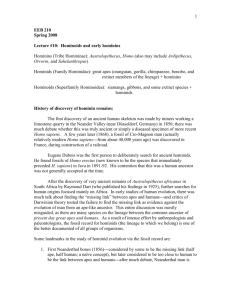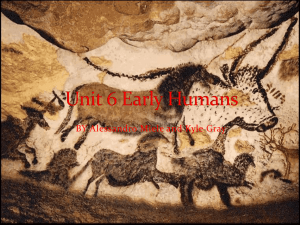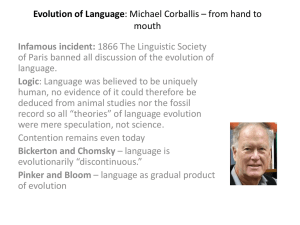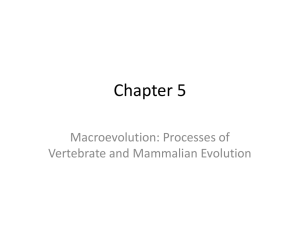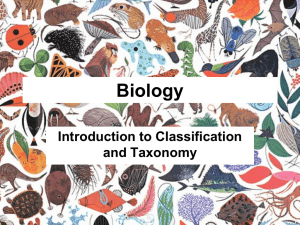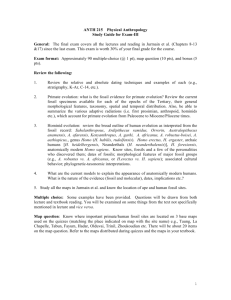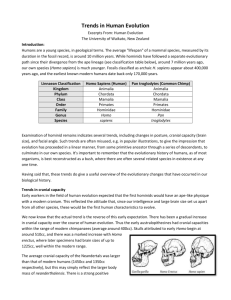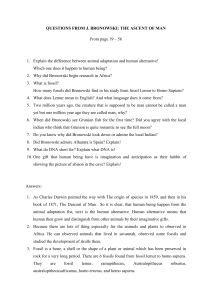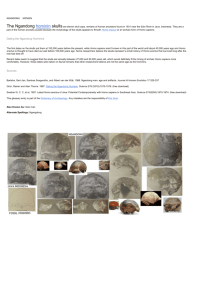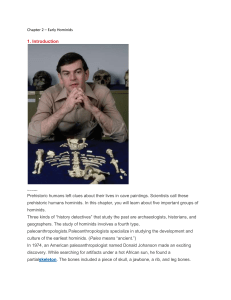Early Hominid Mapping Coordinates & Questions
advertisement
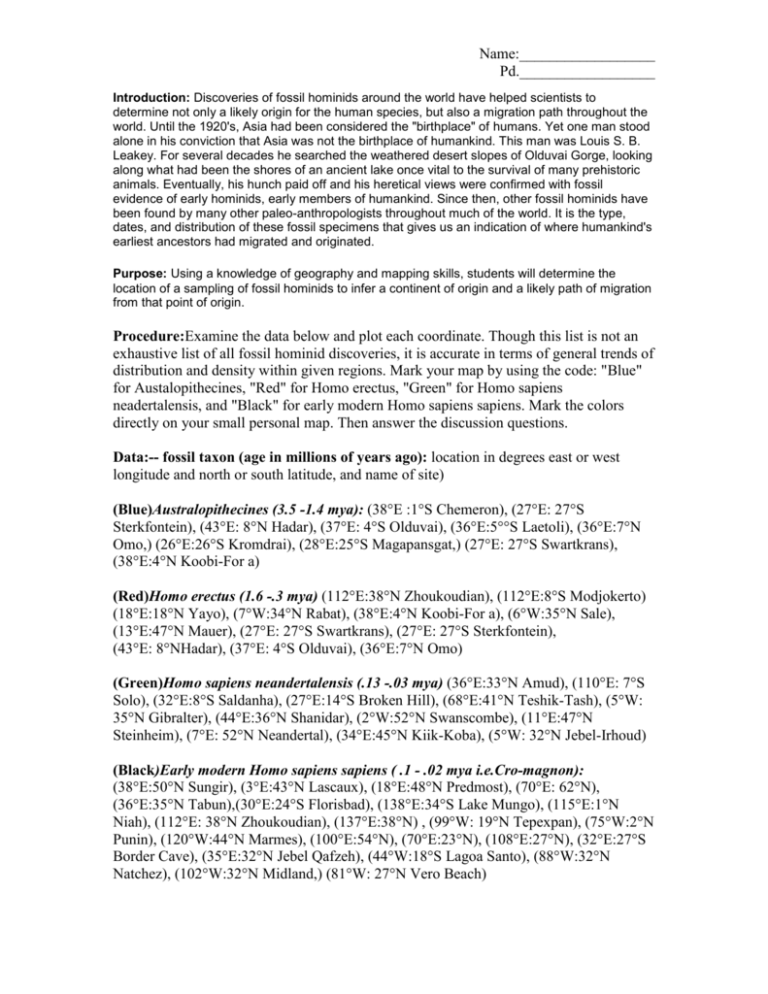
Name:__________________ Pd.__________________ Introduction: Discoveries of fossil hominids around the world have helped scientists to determine not only a likely origin for the human species, but also a migration path throughout the world. Until the 1920's, Asia had been considered the "birthplace" of humans. Yet one man stood alone in his conviction that Asia was not the birthplace of humankind. This man was Louis S. B. Leakey. For several decades he searched the weathered desert slopes of Olduvai Gorge, looking along what had been the shores of an ancient lake once vital to the survival of many prehistoric animals. Eventually, his hunch paid off and his heretical views were confirmed with fossil evidence of early hominids, early members of humankind. Since then, other fossil hominids have been found by many other paleo-anthropologists throughout much of the world. It is the type, dates, and distribution of these fossil specimens that gives us an indication of where humankind's earliest ancestors had migrated and originated. Purpose: Using a knowledge of geography and mapping skills, students will determine the location of a sampling of fossil hominids to infer a continent of origin and a likely path of migration from that point of origin. Procedure:Examine the data below and plot each coordinate. Though this list is not an exhaustive list of all fossil hominid discoveries, it is accurate in terms of general trends of distribution and density within given regions. Mark your map by using the code: "Blue" for Austalopithecines, "Red" for Homo erectus, "Green" for Homo sapiens neadertalensis, and "Black" for early modern Homo sapiens sapiens. Mark the colors directly on your small personal map. Then answer the discussion questions. Data:-- fossil taxon (age in millions of years ago): location in degrees east or west longitude and north or south latitude, and name of site) (Blue)Australopithecines (3.5 -1.4 mya): (38°E :1°S Chemeron), (27°E: 27°S Sterkfontein), (43°E: 8°N Hadar), (37°E: 4°S Olduvai), (36°E:5°°S Laetoli), (36°E:7°N Omo,) (26°E:26°S Kromdrai), (28°E:25°S Magapansgat,) (27°E: 27°S Swartkrans), (38°E:4°N Koobi-For a) (Red)Homo erectus (1.6 -.3 mya) (112°E:38°N Zhoukoudian), (112°E:8°S Modjokerto) (18°E:18°N Yayo), (7°W:34°N Rabat), (38°E:4°N Koobi-For a), (6°W:35°N Sale), (13°E:47°N Mauer), (27°E: 27°S Swartkrans), (27°E: 27°S Sterkfontein), (43°E: 8°NHadar), (37°E: 4°S Olduvai), (36°E:7°N Omo) (Green)Homo sapiens neandertalensis (.13 -.03 mya) (36°E:33°N Amud), (110°E: 7°S Solo), (32°E:8°S Saldanha), (27°E:14°S Broken Hill), (68°E:41°N Teshik-Tash), (5°W: 35°N Gibralter), (44°E:36°N Shanidar), (2°W:52°N Swanscombe), (11°E:47°N Steinheim), (7°E: 52°N Neandertal), (34°E:45°N Kiik-Koba), (5°W: 32°N Jebel-Irhoud) (Black)Early modern Homo sapiens sapiens ( .1 - .02 mya i.e.Cro-magnon): (38°E:50°N Sungir), (3°E:43°N Lascaux), (18°E:48°N Predmost), (70°E: 62°N), (36°E:35°N Tabun),(30°E:24°S Florisbad), (138°E:34°S Lake Mungo), (115°E:1°N Niah), (112°E: 38°N Zhoukoudian), (137°E:38°N) , (99°W: 19°N Tepexpan), (75°W:2°N Punin), (120°W:44°N Marmes), (100°E:54°N), (70°E:23°N), (108°E:27°N), (32°E:27°S Border Cave), (35°E:32°N Jebel Qafzeh), (44°W:18°S Lagoa Santo), (88°W:32°N Natchez), (102°W:32°N Midland,) (81°W: 27°N Vero Beach) Name:__________________ Pd.__________________ Early Human Migration Questions 1.How many years ago is .3 million years?__________________. .02 million years?_______________. 2. Why do you think scientists concluded that Africa is the "birthplace" of humanity? 3. Find a fossil and write its type (taxon) for each of the following locations below: a. China b. United States c. Mexico d. Australia e. Brazil- f. Indonesia g. Germany h. Ethiopia i. Iraqj. South Africa- 4. Which fossil type is the oldest and the furthest spread apart throughout much of the old world(Africa, Asia, Europe)? How do you think they moved to these places? Pick two sites of the same fossil such as (Homo Erectus) that are widely separated(farthest apart eg. one in Africa, and one in Asia), list them, and infer(guess) the relative age of each specimen. (Which fossil is older than the other and explain your reasoning?) 5. Neanderthal seems to be most prominent in which area of the old world? 6. Early modern Homo sapiens sapiens were the first hominids to enter into which continent(s)? Choose one and describe a possible path of migration. 7. Where is the greatest coexistence between Neanderthals and early modern Homo sapiens sapiens likely to have occurred? Explain how this may have contributed to the extinction of Neanderthals. 8. Describe the overall migration pattern of humans and pre-human ancestors based on the data that you plotted on the map.




